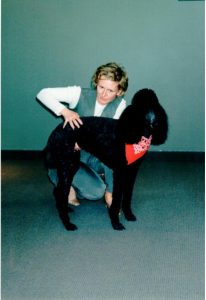Addison’s Disease Part Two: The Nitty Gritty and Storm’s Struggle
Our last blog broadly outlined Addison’s Disease in dogs and the experience of having my own dog diagnosed. Here in part two we will dig deeper into the disease and its affect on Storm.
It all starts with the adrenal glands.
The adrenal glands are vital to help the body fight the effects of physical and emotional stress, viruses, and bacteria. The hormones they produce aid in balancing electrolytes that keep the body hydrated as well as the heart pumping and muscles contracting. These vital organs sit on top of the kidney. The adrenals have two outside layers that produce cortisol and aldosterone. The inner layer is called the medulla, it produces epinephrine to deal with sudden stress responses but has no part in Addison’s Disease.
The Role Of Cortisol:
- Decreases inflammation
- Raises blood sugar
- Suppresses the immune system by decreasing white blood cell production
- Increases fat production
The Role Of Aldosterone:
- Vital for the potassium/sodium balance in the body that controls hydration and most cellular functions. An imbalance creates the classic ‘Addisonian crisis’ and could stop the heart and lead to sudden death.
The adrenals are also affected by the pituitary gland and the hypothalamus in the brain, which send messages to the adrenals to tell them what and how much hormones to produce. Most cases of Addison’s are called Typical Addison’s Disease since the adrenals themselves are under performing. In the Atypical form, the adrenals are functioning but not receiving the ACTH messenger from the brain to stimulate cortisol production. In this blog, we are only dealing with the Typical form.
 My dog Storm did have the usual pattern of symptoms that came and went. We had to keep an eye on her in either very cold or very warm weather. She couldn’t go on long walks. Change was stressful for her, so we never boarded her. Even having my parents, who she knew and loved, come to stay with her proved to be a challenge. We gave her extra medication when it was time for grooming. It certainly took extra planning and awareness but Storm was such a sweet dog. She was happy and loving and well worth it. Storm was playful, loved the kids, and had a gentle nature. She didn’t know that she was sick except for when she had to deal with anything new or stressful. We were always holding our breath to make sure we kept things as routine as possible.
My dog Storm did have the usual pattern of symptoms that came and went. We had to keep an eye on her in either very cold or very warm weather. She couldn’t go on long walks. Change was stressful for her, so we never boarded her. Even having my parents, who she knew and loved, come to stay with her proved to be a challenge. We gave her extra medication when it was time for grooming. It certainly took extra planning and awareness but Storm was such a sweet dog. She was happy and loving and well worth it. Storm was playful, loved the kids, and had a gentle nature. She didn’t know that she was sick except for when she had to deal with anything new or stressful. We were always holding our breath to make sure we kept things as routine as possible.
Because Storm was severely Addisonian, she needed to be treated with two medications for life. One was to replace the cortisol her body was not manufacturing. The most common drug for this is prednisone. The amount changed depending on her situation and what was happening at home. She received prednisone daily.
Her body was also not producing aldosterone. She was given monthly injections of Percorten which replaces the mineralocorticoid (aldosterone) used to help maintain electrolyte balance. We were fortunate that my husband was a horse trainer and had no problem giving injections!
So Why Do Dogs Get Addison’s Disease?
Predisposing factors appear to be :
1. Genetic. It seems to be common in Standard Poodles, Bearded Collies, Portuguese Water Dogs, Rottweilers, and Wheaton Terriers. It is more common in female dogs.
In Storm’s case it turned out that the breeder had had many dogs after Storm’s diagnosis that suffered from Addison’s Disease. The breeder, who was also a vet, ended up stopping her breeding program.
2. Processed foods. Kibble is cheap and convenient, but is made with poor quality ingredients and includes preservatives, synthetic supplements, molds, fungi, and other toxins that can build up in the body and create stress on many organ systems. There are enough pollutants in the environment that we have to be careful not to contribute to toxic build up by feeding poor quality, unnatural kibble.
3. Excessive vaccination and excessive use of chemical flea and tick control.
4. The use of steroid injections as a quick fix for itchy skin. This stresses the adrenals and can make them produce less cortisol over time.
5. Trauma. Physical or emotional abuse, abandonment or neglect. You can image what this does to a dog.
Storm’s Treatment Protocol
As a family we were always aware of what Storm needed. The kids took her on her daily walk with George, our male standard. They were gentle and loving with her even as they dressed her up in their clothes and played house. She loved the attention!
I made it my mission to feed her the best food we could. This was before Lucky Dog Cuisine was born! But, I always cooked for my dogs and fed them whole, natural foods. Whole, moist foods are easy to digest, get absorbed by the body more efficiently and produce fewer free radicals. Cooked, natural meals contain vitamins and minerals in balance, the way nature intended. Storm was also given probiotics and digestive enzymes to help her immune system.
 We rarely vaccinated her and I always used chemical free flea and tick repellents. Our girl did need to receive her daily prednisone and monthly Percorten injections. We had many trips to the vet for IV hydration when, in spite of all our precautions, she had a crisis. Being a chiropractor, I also adjusted her on a regular basis to encourage normal energy flow to the kidney and adrenals. I am a huge fan of acupuncture as well.
We rarely vaccinated her and I always used chemical free flea and tick repellents. Our girl did need to receive her daily prednisone and monthly Percorten injections. We had many trips to the vet for IV hydration when, in spite of all our precautions, she had a crisis. Being a chiropractor, I also adjusted her on a regular basis to encourage normal energy flow to the kidney and adrenals. I am a huge fan of acupuncture as well.
Storm lived a long life for a severely Addisonian dog. She was 11 when she passed away from a sudden bleed in her intestines. We were unable to find the cause in time and she died in my arms. It’s never easy to say goodbye to a beloved family member, we loved her and provided the best life we could. I know that she was comfortable and happy most of the time. The great thing about dogs is that they live in the moment. She never worried about her next episode, she just enjoyed life.





